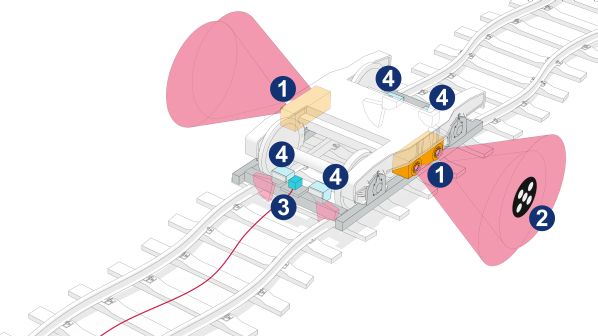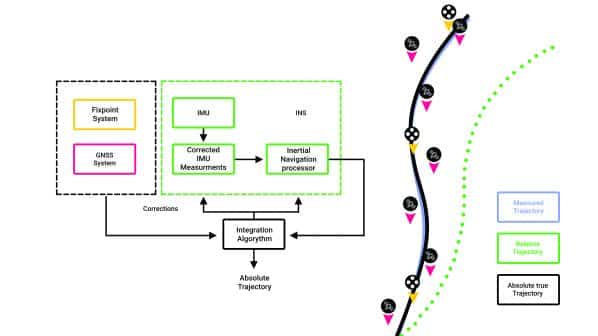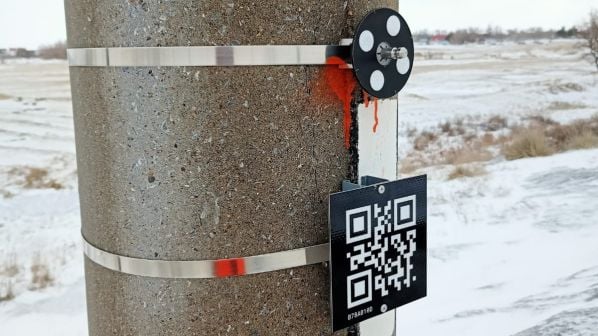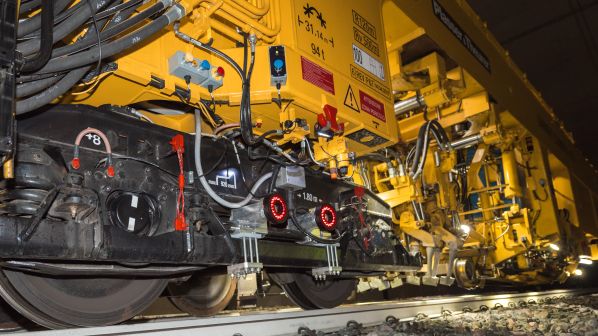BOTH the construction and efficient maintenance of railway infrastructure, and especially of plain line track, require precise measurement of track geometry to ensure that the specified standards have been met. A high degree of accuracy can be achieved with conventional methods, such as the compensation method or spot fault correction, but these methods always refer only to the relative or inner geometry.
As these measurements are taken without any reference to external reference points, such as track marking points (TMPs), it is possible to produce track geometry that complies with the required standards. However, it is not possible to ensure that the track is within all tolerance ranges with regard to surrounding reference points, such as adjacent tracks or platform edges. This has to be checked separately using elaborate manual measurement methods.
If track geometry is measured in relation to these fixed reference points, then this is known as referenced or outer track geometry. Plasser & Theurer and Track Machines Connected (TMC) have jointly developed the Referenced Track Geometry (RTG) system to measure these reference points, based on hardware and software developed by TMC and installed on Plasser & Theurer track maintenance machines.
RTG enables precise measurement of referenced track geometry at high speeds while retaining measurement accuracy, and does not require a track possession to undertake this task. The vehicle-mounted RTG hardware (Figure 1) includes a stereo camera system of high-speed cameras and infrared ring lights (1) which can determine position relative to special lineside measuring markers (2) in the sub-millimetre range at a distance of several metres. The camera system can be installed on both sides of a machine and operated in parallel, enabling all the required data to be recorded in a single measuring run.

In addition, measurement is also carried out using the proven PosTG track geometry measuring system, which consists of an inertial measurement unit (3), systems for track gauge and distance measurement (4) and GNSS antennas. With RTG and PosTG equipment installed on a bogie or special measuring frame, the data gathered by both systems can be compared. The final stage of the process uses the PosTG track gauge measurement to reference data to the rail or wheel flange contact point.
To use this data for planning track maintenance work, recorded measuring data is combined with design track geometry data. Here, referencing measuring data to the wheel flange contact point is relevant, as target distances are defined in term of the horizontal and vertical distance between the reference point and the wheel flange contact point. By additionally defining the target track geometry, all relevant information is available to calculate the correction data and ensure that the track is lifted or lined to achieve the precise distances required. This data can be fed into the control system of a tamping machine for corrective maintenance.
The fully digital RTG system enables infrastructure managers and those undertaking tracklaying or infrastructure maintenance to achieve high levels of accuracy and conduct measurement at speeds of up to 80km/h, which significantly reduces the cost of measurement work. In addition, workforce safety is improved, as staff no longer have to work on or around the track as measurement is undertaken.
RTG is now in use in Austria, Germany and Malaysia, and further applications are being developed. As track maintenance work faces increasing time and cost pressure, the RTG system can be installed on tamping machines (Figure 2) to remove the need for specialised track inspection vehicles and manually-operated measuring devices. Installing precise measurement technology on track construction and maintenance machines faces the challenges of limited space and harsh ambient conditions when the machines are in operation.
Separating the measurement and production processes is essential and can be achieved by carefully positioning the measuring systems and adopting protective measures. It is important that the systems are flexible enough to be operated from different cabs and that remote data access is provided, enabling data to be processed in the back office.
The first deployment of the RTG system on a track construction and maintenance machine has been undertaken in Italy, where it has been fitted to Plasser & Theurer Unimat Combi 08-275 tamping, levelling and lining machines to test its use in track geometry measurement on high-speed lines. The trials have demonstrated that the required level of accuracy can be achieved, and that the new RTG system is as reliable as the proven EM-SAT system previously developed by Plasser & Theurer.
Modern tamping machines rely on precise prior measurement of track geometry to achieve optimum results, requiring measuring runs to be undertaken with track inspection vehicles or the use of manual measuring devices. By using the RTG system, tamping machines can now perform these measurements independently of other vehicles or devices, greatly increasing worksite efficiency and enabling track geometry measurement to be undertaken during the tamping process itself.
Portable RTG in Japan
Ballast replacement on the railway network in Japan requires the distance between the track to be treated and the adjacent track to be measured several times, not only to correct relative track geometry after replacing the ballast but also to restore the track to its original position in relation to adjacent tracks, the overhead contact line and platform edges.
Measurement has to date been a manual process and therefore both time-consuming and prone to error, but has now entered the digital era with the development of a portable RTG (pRTG) system that features stereo cameras system mounted on a manually-operated measuring trolley. No IMU is installed, but the system is able to measure superelevation measurement. The trolley is also equipped with a laptop, an encoder and a battery, which allows the system to be operated autonomously even during longer measuring inspections.
The pRTG system initially measures track position relative to temporary markers placed along the line and saves this data. After the ballast bed has been replaced, the trolley is pushed along the line a second time to measure the position relative to these markers once again. This determines the difference between the horizontal and vertical values of the first reference measurement and the second measurement undertaken after ballast replacement, which can now be used to calculate correction data. Finally, after the track geometry has been restored to the required parameters by a tamping machine, a third measurement is taken with the trolley to check that these correspond to the original condition once more.
Introducing the semi-automated pRTG has considerably increased the efficiency of this process, saving time, avoiding error and increasing the reliability of the measurements gathered by reducing the amount of manual intervention required. Following successful initial system testing, extended trials with different manually-operated measuring trolleys are now in progress to optimise the concept for use on different line sections.
Absolute track axis

TMC has also developed Absolute Track Geometry (ATG) software to calculate the absolute track axis with a high degree of precision, using RTG data in a separate, downstream post-processing method. This has already been used successfully several times in Germany and has been demonstrated in Sweden as part of a Shift2Rail project in 2022. During the trial, RTG measuring markers were installed on a 1km section of track near Attarp, and measuring runs were carried out before and after tamping.
Using a multi-step, iterative process (Figure 3), a millimetre-accurate trajectory was calculated from a combination of corrected GNSS coordinates, IMU measurements, and the stereo camera measurements. Finally, by compensating for bogie movement, the absolute track axis was calculated and produced as a system of coordinates as required by the project. Country-specific definitions of the track axis for Sweden were also taken into account. Processing undertaken after several measuring runs enabled measurements taken by the tamping machine to be compared with absolute values.
The Blue Eagle project in Kazakhstan aims to optimise railway infrastructure and its lifecycle by adopting a holistic end-to-end maintenance concept based on full deployment of digital solutions. A central management system is being created at the heart of a network using data collected by retrofitted track machines and a measuring trailer equipped with the latest measurement technology.
Central to this concept is moving maintenance to the precision method, where the track is measured and treated on the basis of RTG. A measuring trailer capable of operating in service trains has been fitted with RTG and measuring markers have been installed across the network. To ensure that the measuring trailers and their systems operate as autonomously as possible, and at a high frequency in regular service trains, a QR code is also attached near the measuring marker (Figure 4). This enables the location of the marker to be clearly determined and the precise location of the trailer on the network to be identified during measurement runs.

Based on this development of the RTG system, it is possible to develop an autonomous system that works automatically, knows its exact position on network and can therefore produce high-quality measurement data at regular intervals without manual intervention. Measurement data can also be transferred automatically by networking systems, providing the central management system with the most up-to-date information possible, and enabling the most appropriate measures for maintaining the infrastructure to be determined accurately and efficiently.
*Alexander Brennsteiner is product manager for digital products at Plasser & Theurer, and Benjamin Stuntner is head of product management & NPI at Track Machines Connected.

